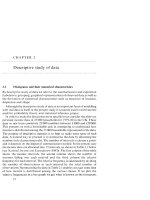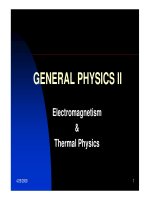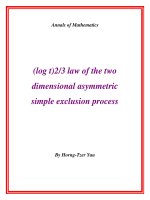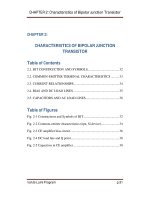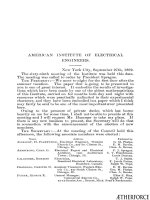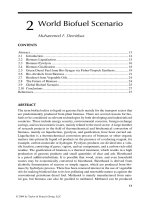Chapter 2 first law of TMD
Bạn đang xem bản rút gọn của tài liệu. Xem và tải ngay bản đầy đủ của tài liệu tại đây (1.66 MB, 38 trang )
PHYSICAL CHEMISTRY 1
Chapter 2 – First law of thermodynamics
Dr. Ngo Thanh An
Chapter 2 – First law of thermodynamics
1. Joule’s experiment
As the weights fall, they give up potential energy and warm the water
accordingly. This was first demonstrated by James Joule, for whom the unit of
energy is named.
Schematic diagram for Joule´s experiment.
Insulating walls to prevent heat transfer
enclose water.
As the weights fall at constant speed, they
turn a paddle wheel, which does work on
water.
If friction in mechanism is negligible, the work
done by the paddle wheel on the water equal
the change of potential energy of the weights.
Chapter 2 – First law of thermodynamics
2. Internal energy
Internal energy involves energy on the microscopic scale
For thermochemistry the internal energy
is the sum of the kinetic energy of motion of
the molecules, and the potential energy
represented by the chemical bonds
between the atoms and any other
intermolecular forces that may be
operative.
Chapter 2 – First law of thermodynamics
3. Statement of First law of thermodynamics
∆U = Q - A
Chapter 2 – First law of thermodynamics
3. Statement of First law of thermodynamics
U: state function
∆ U = Q1 – A1
= Q2 – A2
= Q3 – A3
For a infinitesimal process
Where:
“d” used for describing state function
“δ” used for describing path function
2
A1
Q1
Q2
1
A2
Q3
dU = δ Q − δ A
A3
Chapter 2 – First Law of Thermodynamics
3. Statement of First law of thermodynamics
Meaning of exact differential
Chapter 2 – First law of thermodynamics
Heat vs. Work
Thermodynamic definition of work: It is a kind of interaction that would occur at the
system boundaries. It can be positive or negative.
Chapter 2 – First law of thermodynamics
Heat vs. Work
Chapter 2 – First law of thermodynamics
Heat vs. Work
Chapter 2 – First law of thermodynamics
Heat vs. Work
Endothermic
Chapter
2 – exothermic
First law of thermodynamics
Adiabatic system
Work
(A)
Heat (Q)
release
>0
<0
absorb
<0
>0
Isothermal system
Chapter 2 – First law of thermodynamics
4. Sign convention
Chapter 2 – First law of thermodynamics
4. Sign convention
+
Heat, Qin
System
Heat,
Qout
System
Work,
Wout
Work, Win
Chapter 2 – First law of thermodynamics
Example
In the figure, the gas absorbs 400 J of heat and at the
same time does 120 J of work on the piston. What is the
change in internal energy of the system?
Wby =120 J
∆Q is positive: +400 J (Heat IN)
∆W is negative: -120 J (Work OUT)
∆U = Q + W
= 400 J - 120 J
= +280 J
Qin
400 J
Chapter 2 – First law of thermodynamics
Distinguish between heat, temperature, and thermal energy
• Thermal energy is an energy of the system due to the motion
of its atoms and molecules. Thermal energy is a state variable,
it may change during a process. The system’s thermal energy
continues to exist even if the system is isolated and not
interacting thermally with its environment
• Heat is energy transferred between the system and the
environment as they interact. Heat is not a particular form of
energy, nor is it a state variable. Heat may cause the system’s
thermal energy to change, but that does not mean that heat
and thermal energy are the same thing.
• Temperature is a state variable, it is related to the thermal
energy per molecule. But not the same thing.
Chapter 2 – First law of thermodynamics
5. Specific heat capacity
Def. The specific heat capacity (c) of a substance is the amount of energy needed to
raise the temperature of 1kg of the substance by 1K (or 1 oC)
Chapter 2 – First law of thermodynamics
5. Specific heat capacity
Chapter 2 – First law of thermodynamics
5. Specific heat capacity
Specific average heat capacity:
Q
Q
C=
=
T2 − T1 ∆Τ
Specific heat capacity:
δQ
C=
dT
For 01 mole of ideal gas:
T2
Q = ∫T CdT
CP – CV = R
Effect of temperature on specific heat capacity:
CP = ao + a1T + a2T2
CP = ao + a1T + a-2T-2
CP = Σai Ti (i = 0, 1, 2, –2)
1
Chapter 2 – First law of thermodynamics
5. Specific heat capacity
• For ideal gas:
Cp = Cv +
R
Chapter 2 – First law of thermodynamics
5. Specific heat capacity
Chapter 2 – First law of thermodynamics
5. Specific heat capacity
• Constantpressure specific
• heats for some
gases
Chapter 2 – First law of thermodynamics
6. Application of 1st law of TMD
δ A = p.dV
⇒
⇒
dU = δ Q − p.dV
V2
∆U = Q − ∫V p.dV
1
Chapter 2 – First law of thermodynamics
6. Application of 1st law of TMD
a. Isochoric process (V = const or dV = 0)
V2
dV = 0 → Av = ∫V p.dV = 0
1
⇒
QV = ∆U
Chapter 2 – First law of thermodynamics
6. Application of 1st law of TMD
b. Isobaric process (p = const or dp = 0)
⇒ Ap = ∫V p.dV = p ( V2 − V1 ) = p.∆V
V2
1
⇒ Q p = ∆U + A p = ∆U + p ∆V = ∆U + ∆(pV)
= ∆(U + pV) = ∆H
⇒
QP = ∆H
Enthalpy is the sum of internal energy and the product of pV
